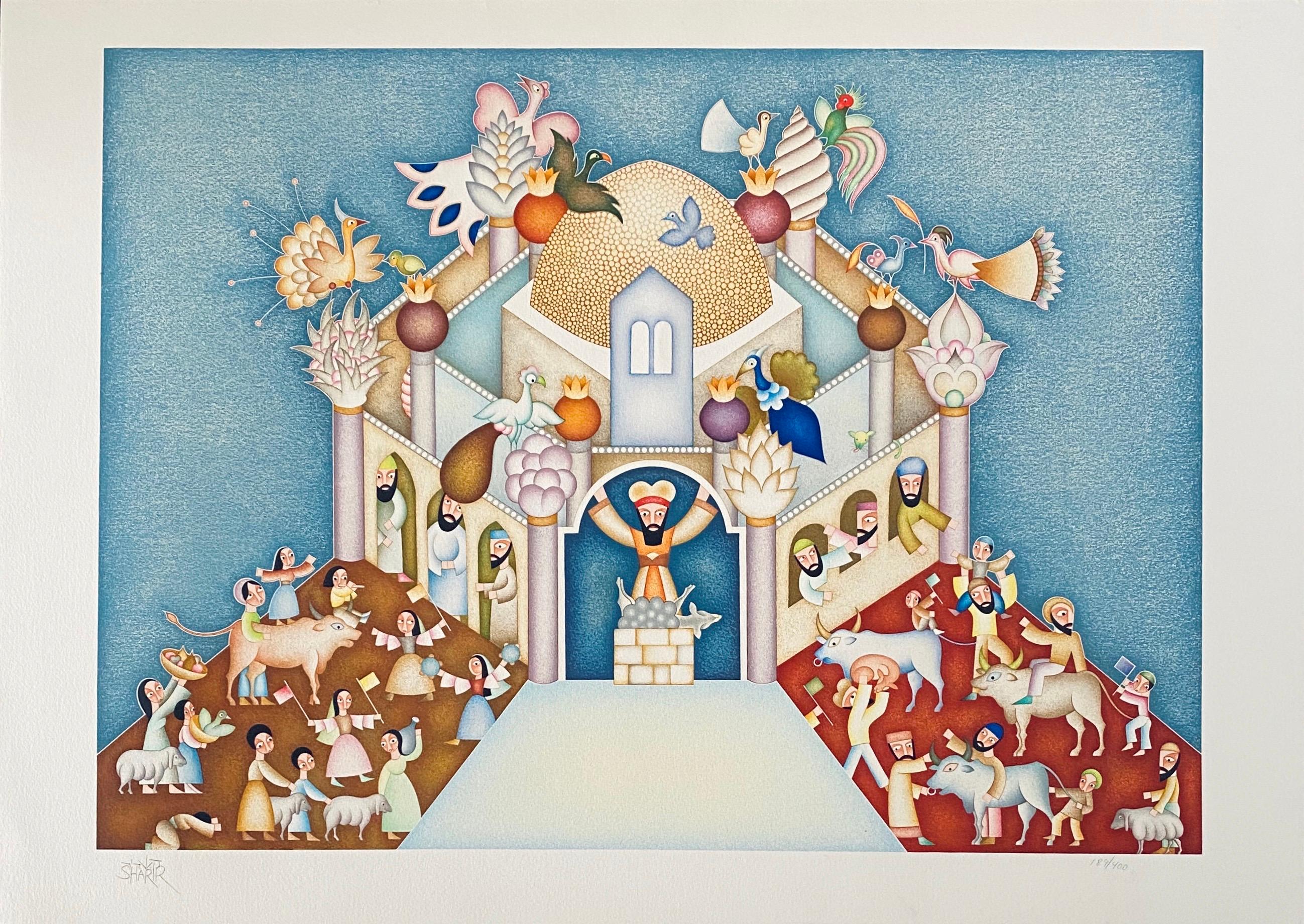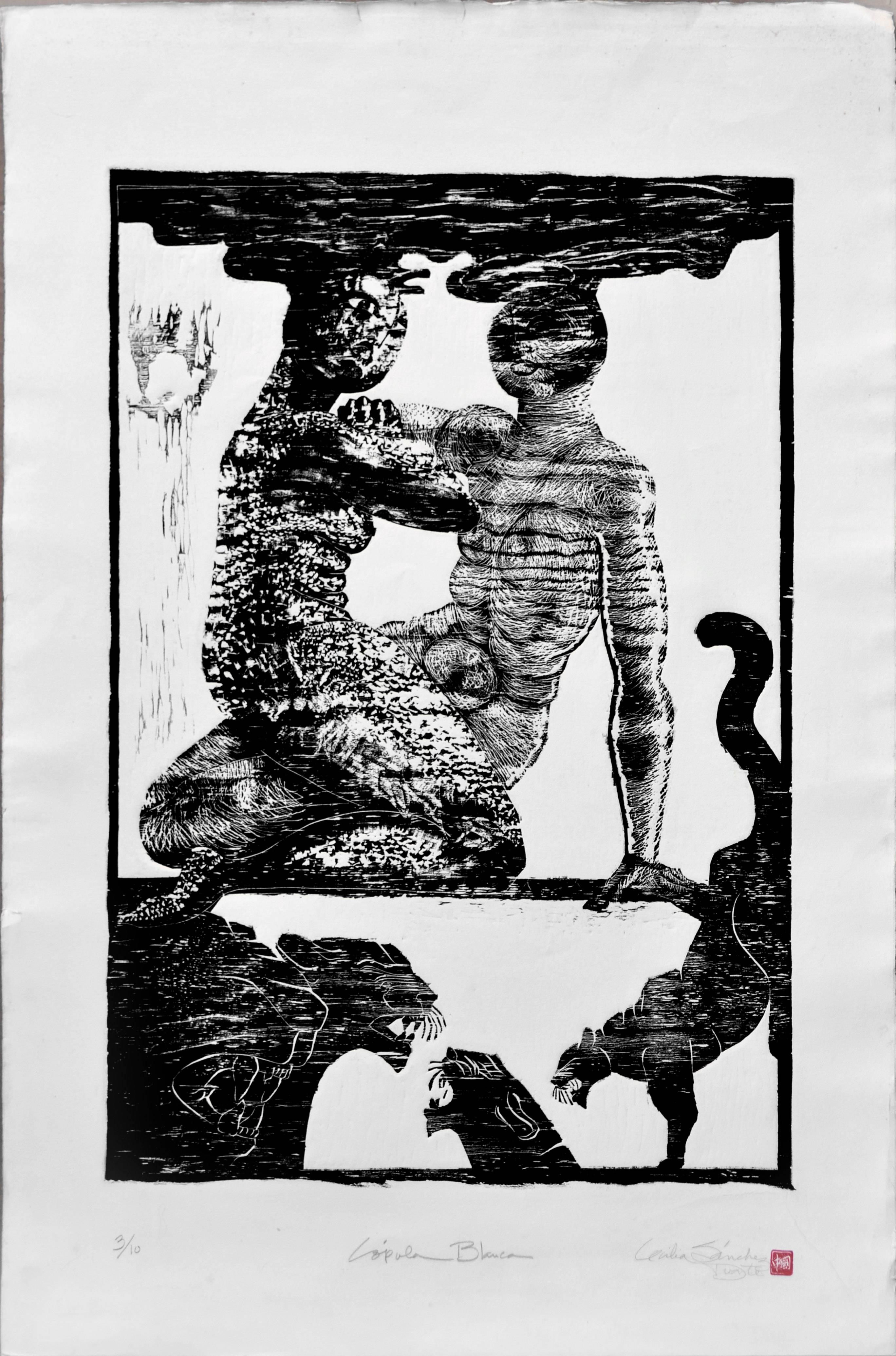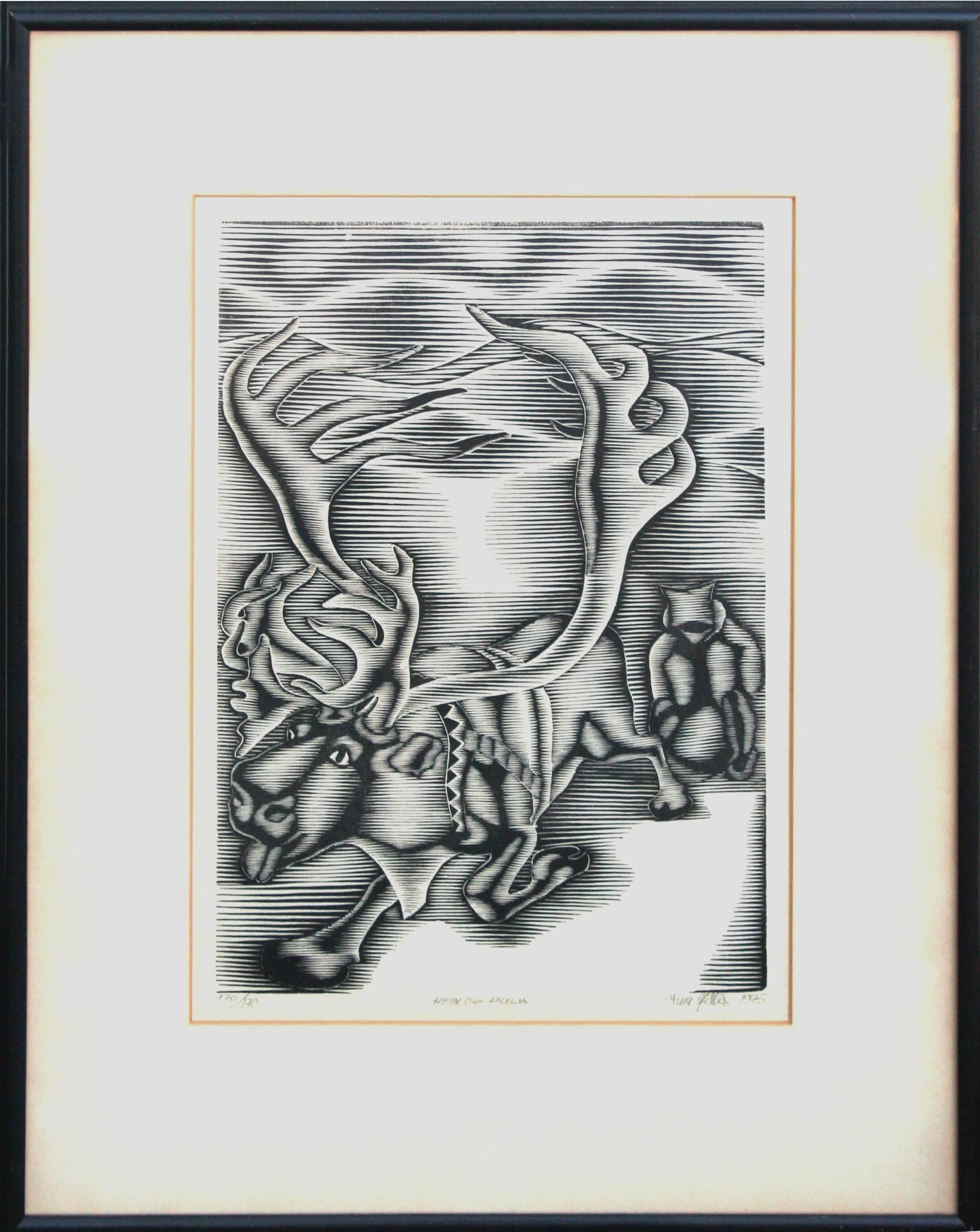Items Similar to Frontline and Homefront diptych
Want more images or videos?
Request additional images or videos from the seller
1 of 10
Harry BunceFrontline and Homefront diptych2021
2021
About the Item
Harry Bunce
Love Wars Series, Frontline
Limited Edition Hand Pulled Silkscreen
Image Size: H 63cm x W 49cm x D 0.1cm
Mounted Size: H 73cm x W 59cm x 0.5cm
Sold Unframed
Love Wars Series, Frontline is a limited edition silkscreen print by Harry Bunce. Each print is unique. Bunce has shot at each print with a Bore shotgun, peppering the artwork with bullet holes.
Harry Bunce
Love Wars Series, Homefront
Limited Edition Hand Pulled Silkscreen
Image Size: H 63cm x W 49cm x D 0.1cm
Mounted Size: H 73cm x W 59cm x 0.5cm
Sold Unframed
Love Wars Series, Homefront is a limited edition silkscreen print by Harry Bunce. Each print is unique. Bunce has shot at each print with a Bore shotgun, peppering the artwork with bullet holes.
Harry Bunce was born and raised in a small Hampshire village, his family were builders. Following a short and volatile spell at art school he moved west to the city of Bristol. Working in the fashion industry by day he continued to draw and paint by night. Over the years Harry’s work slowly began inhabiting metropolitan walls, galleries and homes. A chance collaboration with screen printing gurus, Screen One, who also worked with Banksy and Nick Walker, introduced a more graphic element to his style, sharpening it’s unique, slightly unnerving edge. His work can possibly best be described as ‘Folk Art’ but defies easy categorisation. He often raises envoironmental concerns and is a fierce defender of the countryside. Cute? Maybe, but seldom completely cuddly. Bunce now lives in rural Somerset, his work is shown throughout Britain and recently made its debut in New York.
- Creator:
- Creation Year:2021
- Dimensions:Height: 28.75 in (73 cm)Width: 23.23 in (59 cm)Depth: 0.2 in (5 mm)
- Medium:
- Movement & Style:
- Period:
- Framing:Framing Options Available
- Condition:
- Gallery Location:Deddington, GB
- Reference Number:1stDibs: LU63239504542
About the Seller
5.0
Platinum Seller
These expertly vetted sellers are 1stDibs' most experienced sellers and are rated highest by our customers.
Established in 2014
1stDibs seller since 2017
962 sales on 1stDibs
Typical response time: 1 hour
- ShippingRetrieving quote...Ships From: Deddington, United Kingdom
- Return PolicyA return for this item may be initiated within 14 days of delivery.
More From This SellerView All
- Wes Andersons’s dog and Edward Hopper’s Dog by Mychael Barratt, Limited editionBy Mychael BarrattLocated in Deddington, GBWes Andersons’s dog – Hoover Building II By Mychael Barratt [2021] limited_edition and hand signed by the artist Silkscreen print on paper Edition number...Category
21st Century and Contemporary Contemporary Animal Prints
MaterialsScreen, Paper
- The Golden Goose, Animal Art, Bird Art, Blue and Gold Art, Statement ArtBy Gavin DobsonLocated in Deddington, GBThis is a beautiful hand printed silkscreen from an original painting which I did. A complex CMYK screen print hand finished with gold foiling. The piece is based on the famous fable...Category
21st Century and Contemporary Contemporary Animal Prints
MaterialsPaper, Screen
- Life in Technicolor, Anne Storno, Limited edition print, contemporary artBy Anne StornoLocated in Deddington, GBLife in Technicolor by Anne Storno Limited edition print and hand signed by the artist Edition of 12 Screenprint on Paper Image size: H:30cm x W:40cm Complete size of unframed work: H:30cm x W:40cm x D:0.1cm Please note that insitu images are purely an indication of how a piece may look A Bengale cat printed in fluorescent pink and blue on a bright orange background. This background provides a modern and pop touch. This a very colourful artwork with bright and shiny colours that gives energy, happiness and brings life in a room. The title makes a reference to a song by Coldplay, one of my favorite music group...Category
21st Century and Contemporary Contemporary Figurative Prints
MaterialsPaper, Screen
- Meekat, Flamingo and Ring Tailed LemurBy Fiona HamiltonLocated in Deddington, GBMeerkat by Fiona Hamilton [2018] limited_edition Screen print on paper Edition number 20 Image size: H:35 cm x W:25 cm Complete Size of Unframed Work: H:35 cm x W:25 cm x D:0.1mmcm ...Category
21st Century and Contemporary Contemporary Animal Prints
MaterialsPaper, Screen
- Mini Sea horse and Mini crab by Gavin Dobson, Limited edition diptych, Pop artBy Gavin DobsonLocated in Deddington, GBOverall size - H42 x W29.6 Mini crab by Gavin Dobson [2021] limited_edition Cymk screen print Edition number 100 Image size: H:21 cm x W:14.8 cm Complete Size of Unframed Work: H:2...Category
21st Century and Contemporary Contemporary Figurative Prints
MaterialsPaper, Screen
- Leonardo da Vinci’s Dog and Picasso’s CatBy Mychael BarrattLocated in Deddington, GBPicasso’s Cat by Mychael Barratt [2021] limited_edition Silkscreen print on canvas Edition number 100 Image size: H:21.5 cm x W:21.5 cm Complete Size of U...Category
21st Century and Contemporary Contemporary Animal Prints
MaterialsPaper, Screen
You May Also Like
- Israeli Naive Folk Art Birdhouse Silkscreen Lithograph David Sharir BirdsBy David SharirLocated in Surfside, FLDavid Sharir was born in 1938 in Tel Aviv, Israel and currently resides there. David Sharir, the son of Russian immigrants, was born in Israel. Beginning his study of art in Tel Aviv and continuing in Florence and Rome, where he studied architecture and theater design. The brightly colored costumes and intricate stage designs he created for these productions have profoundly influenced his art. When Sharir moved to Old Jaffa in 1966, his hallmark style was truly developed. Studio, family, and spiritual devotion all serve as inspiration for the imagery in his work. His evolving style combines personal experience, Biblical symbolism, and fantasy. Israel has had a Vibrant Folk Art, Naive art scene for a long time now artists like Yisrael Paldi, Nahum Guttman, Reuven Rubin and even Yefim Ladyzhensky had naive periods. The most well know if the strict naive artists are Shalom of Safed, Irene Awret Gabriel Cohen, Natan Heber, Michael Falk Kopel Gurwin. Sharir depicted biblical subjects with a touch of humour and designed sets and costumes for the theatre and opera. Graphic Art in Israel Today Tel Aviv Museum, Tel Aviv 1973 Israel 1948-1958: Watercolors, Drawings, Graphics The Bezalel National Museum, Jerusalem 1958 Jean David, Yosl Bergner, Menachem Shemi, Zvi Mairovich, Ruth Schloss, Nahum Gutman...Category
20th Century Folk Art Figurative Prints
MaterialsScreen
- Israeli Naive Folk Art Silkscreen Lithograph David Sharir - Bet Hamikdash SceneBy David SharirLocated in Surfside, FLDavid Sharir was born in 1938 in Tel Aviv, Israel and currently resides there. David Sharir, the son of Russian immigrants, was born in Israel. Beginning his study of art in Tel Aviv and continuing in Florence and Rome, where he studied architecture and theater design. The brightly colored costumes and intricate stage designs he created for these productions have profoundly influenced his art. When Sharir moved to Old Jaffa in 1966, his hallmark style was truly developed. Studio, family, and spiritual devotion all serve as inspiration for the imagery in his work. His evolving style combines personal experience, Biblical symbolism, and fantasy. Israel has had a Vibrant Folk Art, Naive art scene for a long time now artists like Yisrael Paldi, Nahum Guttman, Reuven Rubin and even Yefim Ladyzhensky had naive periods. The most well know if the strict naive artists are Shalom of Safed, Irene Awret Gabriel Cohen, Natan Heber, Michael Falk Kopel Gurwin. Sharir depicted biblical subjects with a touch of humour and designed sets and costumes for the theatre and opera. Graphic Art in Israel Today Tel Aviv Museum, Tel Aviv 1973 Israel 1948-1958: Watercolors, Drawings, Graphics The Bezalel National Museum, Jerusalem 1958 Jean David, Yosl Bergner, Menachem Shemi, Zvi Mairovich, Ruth Schloss, Nahum Gutman...Category
20th Century Folk Art Figurative Prints
MaterialsScreen
- Panther - Figurative Abstract Woodcut, 3/10By Cecelia Sánchez DuarteLocated in Soquel, CAFigurative abstract wood cut print titled "Copula Blanca" by Cecelia Sánchez Duarte. Pencil signed with edition number "3/10," title, and signature bottom margin. Image, 31.25"H x 23...Category
1990s Folk Art Figurative Prints
MaterialsArchival Paper, Woodcut
- Rein Og Pulk (Reindeer and Sleighs) - Laplander Sami in his PulkBy Yuri MotLocated in Soquel, CAJoyful image of a woodcut print of a Reindeer pulling a Laplander Sami in his Pulk (small toboggan), a traditional scene in Lapland folklore and history by Yuri Mot. Signed indistinc...Category
1970s Folk Art Figurative Prints
MaterialsWoodcut, Laid Paper
- Feast and singing. 1984. Paper, linocut, 20x34 cmBy Dainis RozkalnsLocated in Riga, LVFeast and singing. 1984. Paper, linocut, 20x34 cm imprint size 10x26 cm total page size 20x34cm Dainis Rozkalns (1928 - 2018) Artist, graphic artist, illustrator of folklore and fi...Category
1980s Folk Art Figurative Prints
MaterialsPaper, Linocut
- Feeding the RavensLocated in San Francisco, CAThis artwork titled "Feeding the Ravens" 1997 is a color offset lithograph on paper by noted American artist Rie Mounier Munoz, 1921-2015. It is hand signed and numbered 29/950 in pencil by the artist. The image size is 9.65 x 8.35 inches, sheet size is 13.85 x 12.25 inches. It is in excellent condition, has never been framed. About the artist: Alaska painter Rie Mounier Munoz was the child of Dutch parents who immigrated to California, where she was born and raised. She is known for her colorful scenes of everyday life in Alaska. Rie (from Marie) Munoz (moo nyos), studied art at Washington and Lee University in Virginia. In 1950, she traveled up the Inside Passage by steamship, fell in love with Juneau, and gave herself until the boat left the next day to find a job and a place to live. Since then Juneau has been home to Munoz. She began painting small vignettes of Alaska soon after arriving in Juneau, and also studied art at the University of Alaska-Juneau. Munoz painted in oils in what she describes as a "painstakingly realistic" style, which she found stiff and "somewhat boring." Her breakthrough came a few years later when an artist friend introduced her to a versatile, water-soluble paint called casein. The immediacy of this inexpensive medium prompted an entirely new style. Rie's paintings became colorful and carefree, mirroring her own optimistic attitude toward life. With her newfound technique she set about recording everyday scenes of Alaskans at work and at play. Of the many jobs she has held journalist, teacher, museum curator, artist, mother, Munoz recalls one of her most memorable was as a teacher on King Island in 1951, where she taught 25 Eskimo children. The island was a 13-hour umiak (a walrus skin boat) voyage from Nome, an experience she remembers vividly. After teaching in the Inupiat Eskimo village on the island with her husband during one school year, she felt a special affinity for Alaska's Native peoples and deliberately set about recording their traditional lifestyles that she knew to be changing very fast. For the next twenty years, Rie practiced her art as a "Sunday painter," in and around prospecting with her husband, raising a son, and working as a freelance commercial artist, illustrator, cartoonist, and curator of exhibits for the Alaska State Museum. During her years in Alaska, Munoz has lived in a variety of small Alaskan communities, including prospecting and mining camps. Her paintings reflect an interest in the day-to-day activities of village life such as fishing, berry picking, children at play, as well as her love of folklore and legends. Munoz says that what has appealed to her most were "images you might not think an artist would want to paint," such as people butchering crab, skinning a seal, or doing their laundry in a hand-cranked washing machine. In 1972, with her hand-cut stencil and serigraph prints selling well in four locations in Alaska, she felt confident enough to leave her job at the Alaska State Museum and devote herself full time to her art. Freed from the constraints of an office job, she began to produce close to a hundred paintings a year, in addition to stone lithograph and serigraph prints. From her earliest days as an artist, Rie had firm beliefs about selling her work. First, she insisted the edition size should be kept modest. When she decided in 1973 to reproduce Eskimo Story Teller as an offset lithography print and found the minimum print run to be 500, she destroyed 200 of the prints. She did the same with King Island, her second reproduction. Reluctantly, to meet market demand, she increased the edition size of the reproductions to 500 and then 750. The editions stayed at that level for almost ten years before climbing to 950 and 1250. Her work has been exhibited many solo watercolor exhibits in Alaska, Oregon and Washington State, including the Charles and Emma Frye Art Museum, Alaska State Museum in Juneau, Anchorage Historical and Fine Arts Museum, Tongass Historical Museum in Ketchikan, and Yukon Regional Library in Whitehorse; Yukon Territory, and included in exhibits at the Smithsonian Institute and Russell Senate Office Building in Washington, D.C. Munozs paintings have graced the covers of countless publications, from cookbooks to mail order catalogs, and been published in magazines, newspapers, posters, calendars, and two previous collections of her work: Rie Munoz...Category
Late 20th Century Folk Art Animal Prints
MaterialsLithograph



